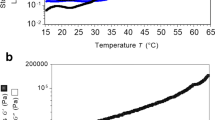Abstract
Ternary colloidal or “capillary” suspensions comprising bulk and secondary fluids (S) and particles have attracted considerable attention in recent years. The addition of a suitable S can readily initiate the transition of a fluid-like pre-mixture into a gel-like capillary suspension. However, the precise control of rheological properties of such suspensions in the gel state is still challenging. In this study, we investigated the effects of the addition of various water-soluble polymers in an aqueous S on the rheological properties of the capillary suspensions. Results suggest that all the investigated systems maintained the gel state. Cellulose-type polymers with high molecular weights increased the sample strength, which was attributed to the gelation and reduced rupture of interparticle capillary bridges. In contrast, the non-cellulose-type polymers decreased the sample strength, which may be attributed to the interparticle repulsion and/or decrease in the capillary force. We believe this study will aid the design of various industrial complex fluids that often contain multiple immiscible fluids and polymeric additives.








Similar content being viewed by others
References
Koos E, Willenbacher N (2011) Capillary forces in suspension rheology. Science 331:897–900
Hauf K, Koos E (2018) Structure of capillary suspensions and their versatile applications in the creation of smart materials. MRS Commun 8:332–342
Farnandm JR, Puddington IE (1969) Oil phase agglomeration of germanium bearing vitrain coal in a shaly sandstone deposit. Can Min Metall Bull 62:267–271
Dittmann J, Koos E, Willenbacher N (2012) Ceramic capillary suspensions: novel processing route for microporous ceramic materials. J Am Ceram Soc 96:391–397
Bitsch B, Dittmann J, Schmitt M, Scharfer P, Schabel W, Willenbacher N (2014) A novel slurry concept for the fabrication of lithiumion battery electrodes with beneficial properties. J Power Sources 265:81–90
Schneider M, Koos E, Willenbacher N (2016) Highly conductive, printable pastes from capillary suspensions. Sci Rep 6:6
Roh S, Parekh DP, Bharti B, Stoyanov SD, Velev OD (2017) 3D Printing by multiphase silicone/water capillary inks. Adv Mater 29:1701554
Maurath J, Willenbacher N (2017) 3D printing of open-porous cellular ceramics with high specific strength. J Eur Ceram Soc 37:4833–4842
Hoffmann S, Koos E, Willenbacher N (2014) Using capillary bridges to tune stability and flow behavior of food suspensions. Food Hydrocolloids 40:44–52
Koos E, Johannsmeier J, Schwebler L, Willenbacher N (2012) Tuning suspension rheology using capillary forces. Soft Matter 8:6620–6628
Yang J, Park H, Kim J, Mok J, Kim T, Shin E, Kwak C, Lim S, Kim CB, Park J-S, Na HB, Choi D, Lee J (2020) Yield stress enhancement of a ternary colloidal suspension via the addition of minute amounts of sodium alginate to the interparticle capillary bridges. Langmuir 36:9424–9435
Bossler F, Weyrauch L, Schmidt R, Koos E (2017) Influence of mixing conditions on the rheological properties and structure of capillary suspensions. Colloids Surf A 518:85–97
Das AAK, Dunstan TS, Stoyanov SD, Starck P, Paunov VN (2017) Thermally responsive capillary suspensions. ACS Appl Mater Interfaces 9:44152–44160
Ahuja A, Gamonpilas C (2021) Rheoloogy of thermo-gelling capillary suspensions. Colloid Polym Sci 299:165–176
Sekiguchi Y, Sawatari C, Kondo T (2003) A gelation mechanism depending on hydrogen bond formation in regioselectively substituted O-methylcellulose. Carbohydr Polym 53:145–153
Hou L, Wu P (2019) Exploring the hydrogen-bond structures in sodium alginate through two-dimensional correlation infrared spectroscopy. Carbohydr Polym 205:420–460
Georgiev MT, Danov KD, Kralchevsky PA, Gurkov TD, Krusteva DP, Arnaudov LN, Stoyanov SD, Pelan EG (2018) Rheology of particle/water/oil three-phase dispersions: electrostatics vs. capillary bridge forces. J Colloid Interface Sci 513:515–526
McCormick CL, Elliott DL (1986) Water-soluble copolymers. 14. Potentiometric and turbidimetric studies of water-soluble copolymers of acrylamide: comparison of carboxylated and sulfonated copolyemrs. Macromolecules 19:542–547
Lee J, Moesari E, Dandamudi CB, Beniah G, Chang B, Iqbal M, Fei Y, Zhou N, Ellison CJ, Johnston KP (2017) Behavior of spherical poly(2-acrylamido-2-methylpropanesulfonate) polyelectrolyte brushes on silica nanoparticles up to extreme salinity with weak divalent cation binding at ambient and high temperature. Macromolecules 50:7699–7711
Park H, Lim S, Yang J, Kwak C, Kim J, Kim J, Choi SS, Kim CB, Lee J (2020) A Systematic investigation on the properties of silica nanoparticles “multipoint”-grafted with poly(2-acrylamido-2-methylpropanesulfonate-co-acrylic acid) in extreme salinity brines and brine−oil interfaces. Langmuir 36:3174–3183
Bagaria HG, Xue Z, Neilson BM, Worthen AJ, Yoon KY, Nayak S, Cheng V, Lee JH, Bielawski CW, Johnston KP (2013) Iron oxide nanoparticles grafted with sulfonated copolymers are stable in concentrated brine at elevated temperatures and weakly adsorb on silica. ACS Appl Mater Interfaces 5:3329–3339
Lee J, Beniah G, Dandamudi CB, Han JJ, Lyon BA, Norton CA, Huffman ND, Johnson LM, Mecham JB, Rothrock GD, Zhou N, Pennell KD, Johnston KP (2018) Noncovalent grafting of polyelectrolytes onto hydrophobic polymer colloids with a swelling agent. Colloids Surf A 555:457–464
Acknowledgements
This research was supported by Basic Science Research Program through National Research Foundation of Korea (NRF) funded by the Ministry of Education (NRF-2018R1D1A1A02085492). This research was supported by Nano∙Material Technology Development Program through the National Research Foundation of Korea (NRF) funded by the Ministry of Science, ICT and Future Planning (2009-0082580). This research was supported by Korea Institute for Advancement of Technology (KIAT) grant funded by the Korea Government (MOTIE) (P0008475, Development Program for Smart Digital Engineering Specialist).
Author information
Authors and Affiliations
Corresponding author
Additional information
Publisher's Note
Springer Nature remains neutral with regard to jurisdictional claims in published maps and institutional affiliations.
Rights and permissions
About this article
Cite this article
Yang, J., Kim, J. & Lee, J. Effects of water-soluble polymers dissolved in an aqueous secondary fluid on the rheological properties of “capillary” suspensions. Korea-Aust. Rheol. J. 34, 159–166 (2022). https://doi.org/10.1007/s13367-022-00027-w
Received:
Revised:
Accepted:
Published:
Issue Date:
DOI: https://doi.org/10.1007/s13367-022-00027-w




